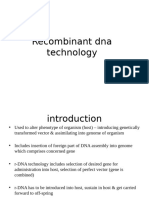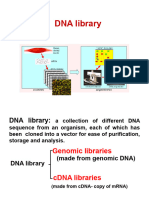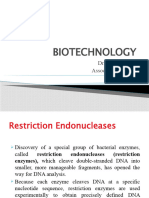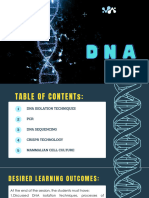0 ratings0% found this document useful (0 votes)
5 viewsGenomics Week III & IV
Genomics Week III & IV
Uploaded by
Muhammad Jawad MalikCopyright:
© All Rights Reserved
Available Formats
Download as PDF, TXT or read online from Scribd
Genomics Week III & IV
Genomics Week III & IV
Uploaded by
Muhammad Jawad Malik0 ratings0% found this document useful (0 votes)
5 views37 pagesCopyright
© © All Rights Reserved
Available Formats
PDF, TXT or read online from Scribd
Share this document
Did you find this document useful?
Is this content inappropriate?
Copyright:
© All Rights Reserved
Available Formats
Download as PDF, TXT or read online from Scribd
Download as pdf or txt
0 ratings0% found this document useful (0 votes)
5 views37 pagesGenomics Week III & IV
Genomics Week III & IV
Uploaded by
Muhammad Jawad MalikCopyright:
© All Rights Reserved
Available Formats
Download as PDF, TXT or read online from Scribd
Download as pdf or txt
You are on page 1of 37
Genomics & Transcriptome
3(3-0)
BIT-504
Prof. Dr. Roquyya Gul
ENZYMES FOR
DNA MANIPULATION
Activities of (A) DnA polymerases, (B) nucleases, (c) ligases, and (D) end -
modification enzymes. (A) Activity of a DNA-dependent DNA polymerase is shown on the left, and
that of an RNA-dependent DNA polymerase is shown on the right. (B) Activities of endonucleases and
exonucleases are shown. (C) Activity of a ligase: the green DNA molecule is ligated to itself (left) or to a
second DNA molecule (right). (D) Activity of terminal deoxynucleotidyl transferase is illustrated: this
enzyme adds nucleotides to the ends of a double-stranded DNA molecule.
Subdividing the Genome
• Fragmentation of DNA with restriction
enzymes
• Separating large fragments of DNA and to
clone
Restriction Enzymes
• For example found in bacteria
• Cut DNA within the molecule (endonuclease), cut at ends
(exonucleases)
• Cut at sequences that are specific for each enzyme (restriction
sites)
• Leave either blunt or sticky ends, depending upon the specific
enzyme
Polymerase Chain Reaction
• PCR allows scientists to amplify small,
specific segments of DNA = make millions
of copies of segment
• Allows for amplification at an exponential
rate
• DNA Replication in a test tube
Materials needed for PCR
• Target DNA (the DNA you want to copy)
• Free Nucleotides (A, T, C, G)
• Primers
• Taq Polymerase (heat stable DNA Polymerase
III)
• Mg2+ (cofactor that DNA Polymerase III needs
to work)
• Buffer
• Thermocycler (machine that changes
temperatures)
Overview of PCR
• Uses different temperatures to amplify
DNA
• Step 1: Separate existing DNA strands –
95ºC (Denaturation)
• Step 2: Lower temperature to allow
primers to bind to target DNA – 55ºC
(Annealing)
• Step 3: Raise temperature to allow Taq
Polymerase to build DNA strand – 72ºC
(Extension)
Differences between DNA Replication
& PCR
• No Helicase or Topoisomerase – PCR uses
the first heat step to completely separate the
strands of DNA
• No Primase – primers are already made
• DNA primers – no need for DNA
Polymerase I
• No leading or lagging strands – DNA is
completely unzipped, no Okazaki fragments
The polymerase chain reaction – used to amplify a
10_27_1_PCR_amplify.jpg
specific DNA sequence with cyclic changes in temperature
Exponential Amplification (at every cycle,
product is doubled)
of template DNA
Denaturation
• Heating separates the
double stranded DNA
–Denaturation
• Slow cooling anneals Heat Cool
the two strands
–Renaturation
Annealing
• Two primers are supplied in molar excess
• They bind to the complementary region
• As the DNA cools, they wedge between
two template strands
• Optimal temperature varies based on
primer length etc.
• Typical temperature from 40-60 ºC
Extension
• DNA polymerase duplicates DNA
• Optimal temperature 72ºC
• Regions of up to 5kb can be amplified
without much difficulty.
• Longer amplifications; up to 40kb are
possible by modifications of the standard
technique.
• Fragments longer than about 40kb are
unattainable by PCR.
Gel electrophoresis is used to examine the
results of PCR OR Restriction digestion
• Two types of gel are used in molecular biology:
• Agarose gels and Polyacrylamide gels, which are
mainly used in DNA sequencing.
• Agarose is a polysaccharide that forms gels with pores
ranging from 100 to 300 nm in diameter; the pore size
depends on the concentration of agarose in the gel.
• Gel concentration therefore determines the range of
DNA fragments that can be separated.
• Agarose gel is composed of microscopic pores through
which DNA travels.
• There is an inverse relationship between the pore size
of the gel and the concentration – pore size decreases
as the density of agarose fibers increases.
• High gel concentration improves separation of
smaller DNA molecules, while lowering gel
concentration permits large DNA molecules to be
separated.
• Depending on the concentration of agarose in the gel,
fragments between 100 bp and 50 kilobase pairs (kb)
in length can be separated into sharp bands after
electrophoresis.
• For example; a 0.5 cm thick slab of 0.5% agarose,
have large pores, used for molecules in the size range
1–30 kb.
• 0.3% gel can be used for longer molecules up to 50
kb.
• 5% gel can be used for shorter molecules 100–500
bp in length.
• The bands of DNA can be visualized by soaking the gel in
ethidium bromide solution OR by adding ethidium bromide in
gel.
• Ethidium bromide (mutagenic) intercalates between DNA base
pairs and fluoresces when activated with ultraviolet radiation.
• Non mutagenic dyes that stain DNA green, red, or blue are
now used in many laboratories. The most sensitive dyes are able
to detect bands less than 1 ng of DNA, as compared to a
minimum of 10 ng of DNA when ethidium bromide is used.
Rate of product formation can be followed during a
PCR
• The synthesis of the DNA product is followed as the PCR
proceeds through its series of cycles is called real-time PCR.
• Carried out in two different ways;
In the simplest method, a dye that gives a fluorescent signal
binds to DNA is included in the PCR mixture.
The gradual increase in the fluorescent signal given out by
the mixture indicates the rate at which the product is being
synthesized.
The disadvantage of this approach is it measures the total
amount of double-stranded DNA in the PCR at any particular
time. This is because the primers sometimes anneal to
themselves in various nonspecific ways, increasing the
amount of double-stranded DNA that is present.
The second method for real-time PCR requires a short
oligonucleotide called a reporter probe, which gives a
fluorescent signal when it hybridizes to the PCR product.
The probe hybridizes only to the PCR product, this
method avoids the problems caused by primer–primer
annealing.
Use of a pair of labels comprising a fluorescent dye and a
compound that quenches the fluorescent signal when
brought into close proximity with the dye.
This quenching is brought about by a process called Förster
resonance energy transfer (FRET).
The dye is attached to one end of the reporter probe and
the quenching compound is attached to the other end.
Applications of real time
quantitative PCR
• relative and absolute quantification
of gene expression.
• validation of DNA micorarray
results.
• variation analysis.
• counting bacterial, viral, or fungal
loads.
• to obtain sequences from the trace
amounts of DNA that are present in
hairs, blood stains, and other forensic
specimens and from bones and other
remains preserved at archaeological
sites.
• to amplify DNA from preserved
skeletons has led to genome
sequences of extinct species.
Ligases join DNA fragments together
Figure 2.16 linkers are used to place sticky
ends onto a blunt-ended molecule. In this
example, each linker contains the recognition
sequence for the restriction endonuclease
BamHI. DNA ligase attaches the linkers to the
ends of the blunt-ended molecule in a reaction
that is made relatively efficient because the
linkers are present at a high concentration. The
restriction enzyme is then added to cleave the
linkers and produce the sticky ends. Note that
during the ligation the linkers ligate to one
another, so a series of linkers (a concatemer) is
attached to each end of the blunt molecule.
When the restriction enzyme is added, these
linker concatemers are cut into segments, with
half of the innermost linker left attached to the
DNA molecule. Adaptors are similar to linkers
but each one has one blunt end and one sticky
end. The blunt-ended DNA is therefore given
sticky ends simply by ligating it to the adaptors:
there is no need to carry out the restriction step
End-modification enzymes
• Terminal deoxynucleotidyl transferase, obtained from calf
thymus tissue an example of an end-modification enzyme.
• It is a template-independent DNA polymerase, because it is
able to extend a DNA polynucleotide without base pairing of
the incoming nucleotides to an existing strand of DNA or
RNA.
• Main role in recombinant DNA technology is in
homopolymer tailing.
• Two end-modification enzymes are frequently used; alkaline
phosphatase and T4 polynucleotide kinase.
• Alkaline phosphatase is obtained from various sources,
including E. coli, calf intestinal tissue, and Arctic shrimp. It
removes phosphate groups from the 5ʹ-ends of DNA
molecules, which prevents these molecules from being
ligated to one another.
• Two ends carrying 5ʹ-phosphates can be ligated to one
another, and an end lacking a phosphate group can be ligated
to an end containing a phosphate, but a link cannot be formed
between a pair of ends if neither carries a 5ʹ-phosphate.
• The use of alkaline phosphatase direct the action of a DNA ligase
so that only desired ligation products are obtained.
• T4 polynucleotide kinase, obtained from E. coli cells infected
with T4 bacteriophage, performs the reverse reaction to
alkaline phosphatase: it adds phosphates to 5ʹ-ends.
• Like alkaline phosphatase, the enzyme is used during complicated
ligation experiments, but its main application is in the end-
labeling of DNA molecules.
You might also like
- MBY 364 NOTES - MergedDocument22 pagesMBY 364 NOTES - Mergedroelienvv7No ratings yet
- PCR Amplification Lab ReportDocument5 pagesPCR Amplification Lab ReportWilson Chan100% (7)
- Recombinant DNA TechnologyDocument26 pagesRecombinant DNA TechnologyManikandan VpNo ratings yet
- Purification, Manipulation and Transformation of Nucleic AcidDocument25 pagesPurification, Manipulation and Transformation of Nucleic AcidTehmina SiddiqueNo ratings yet
- Genetic Engineering MicroDocument15 pagesGenetic Engineering MicroKalaiNo ratings yet
- Polymerase Chain ReactionDocument19 pagesPolymerase Chain Reactionmajov83712No ratings yet
- Nucleic Acid BiotechnologyDocument48 pagesNucleic Acid Biotechnologymonzon.mika1801No ratings yet
- Biochem Lec 3Document97 pagesBiochem Lec 3yashika gargNo ratings yet
- Methods To Study GenesDocument9 pagesMethods To Study GenesAlysa ParoleNo ratings yet
- LigationDocument5 pagesLigationHanumant SuryawanshiNo ratings yet
- DNA Is The Genetic MaterialDocument17 pagesDNA Is The Genetic Materialmozhi74826207No ratings yet
- Recombinant Dna TechnologyDocument41 pagesRecombinant Dna Technologyrakshashree2003No ratings yet
- Polymerase Chain ReactionDocument55 pagesPolymerase Chain ReactionFareeha ZahoorNo ratings yet
- PCR PresentationDocument34 pagesPCR Presentationdurgaprasadhembram1999No ratings yet
- Lec-9 DNA SequencingDocument31 pagesLec-9 DNA SequencingRabiul IslamNo ratings yet
- Polymerase Chain Reaction (PCR)Document67 pagesPolymerase Chain Reaction (PCR)Derick SemNo ratings yet
- DNA LibraryDocument73 pagesDNA LibraryDGA GAMINGNo ratings yet
- BiotechnologyDocument36 pagesBiotechnologyFarwa JawadNo ratings yet
- IGNTU EContent 315483864108 M.SC EnvironmentalScience 2 ManojkumarRai Environmentalmicrobiologyandbiotechnology 3Document66 pagesIGNTU EContent 315483864108 M.SC EnvironmentalScience 2 ManojkumarRai Environmentalmicrobiologyandbiotechnology 3subhasis124p13No ratings yet
- Biology PPT - Polymerase Chain ReactionDocument34 pagesBiology PPT - Polymerase Chain ReactionJay MandalNo ratings yet
- Chemical Synthesis of DNA (1) : Automated Multistep Process Commonly Phosphoramidite ChemistryDocument29 pagesChemical Synthesis of DNA (1) : Automated Multistep Process Commonly Phosphoramidite ChemistryHarish BgNo ratings yet
- 4 - Pharmaceutical Biotechnology (PD523-CCS518) - Lecture Four.Document40 pages4 - Pharmaceutical Biotechnology (PD523-CCS518) - Lecture Four.konouzabousetta2021No ratings yet
- 10 - Basic Recombinant DNA TechniquesDocument77 pages10 - Basic Recombinant DNA TechniquesNguyenHongThamNo ratings yet
- Nucleic Acid Manipulation: The Polymerase Chain ReactionDocument22 pagesNucleic Acid Manipulation: The Polymerase Chain Reactionamor_panopioNo ratings yet
- 9 - Dna Technology - SalesDocument49 pages9 - Dna Technology - SalesJazel SalesNo ratings yet
- I Recombinant DNA TechnologyDocument37 pagesI Recombinant DNA TechnologyGundeep BrarNo ratings yet
- Biology PPT - Polymerase Chain ReactionDocument32 pagesBiology PPT - Polymerase Chain ReactionJay MandalNo ratings yet
- PCRDocument4 pagesPCRDhinchak SowndaryaNo ratings yet
- Reaction Components of PCR: WaterDocument20 pagesReaction Components of PCR: Watermasabatasneem29No ratings yet
- Nucleic Acid Biotechnology Techniques: Mary K. Campbell Shawn O. FarrellDocument40 pagesNucleic Acid Biotechnology Techniques: Mary K. Campbell Shawn O. Farrellleng cuetoNo ratings yet
- GENETICSDocument56 pagesGENETICSKeziah Tayco100% (1)
- DNA SequencingDocument21 pagesDNA SequencingAsfoor gake1100% (1)
- DNA Isolation, PCR & Sequencing: Dr. Dr. Mgs. Irsan Saleh, M.BiomedDocument22 pagesDNA Isolation, PCR & Sequencing: Dr. Dr. Mgs. Irsan Saleh, M.BiomedUmiieg MiansyahNo ratings yet
- Recombinant Techniques, DR Madhushree PahariDocument45 pagesRecombinant Techniques, DR Madhushree PahariMadhushree PahariNo ratings yet
- SEQUENCING ATU OnlineDocument39 pagesSEQUENCING ATU Onlinemaxwell amponsahNo ratings yet
- MBB 130.1 Lab NotesDocument5 pagesMBB 130.1 Lab NotesJonathan ChanNo ratings yet
- RDNA Lect Lecture Notes Mid Sem BTech IDDDocument146 pagesRDNA Lect Lecture Notes Mid Sem BTech IDDarpna sjsNo ratings yet
- Application of Genetics IIDocument47 pagesApplication of Genetics IImakristelanneaNo ratings yet
- Biotechnology CH 3Document48 pagesBiotechnology CH 3ranitede16No ratings yet
- Linker, AdaptorsDocument25 pagesLinker, AdaptorsShanmugapriya100% (1)
- The Overall Replication Process and Synthesis of New DNA Strands Catalyzed by DNA PolymeraseDocument39 pagesThe Overall Replication Process and Synthesis of New DNA Strands Catalyzed by DNA Polymerasemasthan6yNo ratings yet
- Lec 5 DNA Extraction and PCRDocument25 pagesLec 5 DNA Extraction and PCRSaif MohamedNo ratings yet
- Genetics Midterm 2 Study Guide PT 2 Molecular GeneticsDocument6 pagesGenetics Midterm 2 Study Guide PT 2 Molecular GeneticsCheyenne MartinsNo ratings yet
- Useful To Human. Analogues For Products and Services: BIOTECHNOLOGY - Principles and ProcessesDocument10 pagesUseful To Human. Analogues For Products and Services: BIOTECHNOLOGY - Principles and ProcessesKorou LaikhaNo ratings yet
- Chapter-11 Nucleic AcidDocument31 pagesChapter-11 Nucleic AcidMD Limon IslamNo ratings yet
- PCR1Document4 pagesPCR1Hina NoorNo ratings yet
- Experiment No. 15 Practical: Polymerase Chain ReactionDocument8 pagesExperiment No. 15 Practical: Polymerase Chain ReactionAnura BandaraNo ratings yet
- PCR Basics: Kanadi SumaprajaDocument31 pagesPCR Basics: Kanadi SumaprajaSamrichardNo ratings yet
- DNA Sequencing & ApplicationDocument15 pagesDNA Sequencing & Applicationshamidr99No ratings yet
- Recombinant Dna Technology: EcoriDocument2 pagesRecombinant Dna Technology: EcoriluisynonNo ratings yet
- Dna Ligase, Terminal Transferase, Adapter and LinkerDocument80 pagesDna Ligase, Terminal Transferase, Adapter and LinkerSujit ShandilyaNo ratings yet
- Polymerase Chain Reaction (PCR) : Principle of The PCRDocument5 pagesPolymerase Chain Reaction (PCR) : Principle of The PCRSalvador MartinezNo ratings yet
- Activity # 1 - Introduction To Molecular TechniquesDocument14 pagesActivity # 1 - Introduction To Molecular TechniquesJhenica D. NonanNo ratings yet
- Dna Sequencing MethodsDocument29 pagesDna Sequencing MethodsWilson Anandaraj92% (13)
- Biomol 12 - Molecular Biology TechniquesDocument76 pagesBiomol 12 - Molecular Biology TechniquesErin ArmaidaNo ratings yet
- Adapters and LinkersDocument25 pagesAdapters and LinkersDeepika EkambaramNo ratings yet
- PCR LectureDocument18 pagesPCR LecturePagla HowaNo ratings yet
- Next Generation Sequencing - FinalDocument33 pagesNext Generation Sequencing - Finallynn100% (1)
- Biological BackgroundDocument15 pagesBiological Backgroundrustyryan77No ratings yet
- DNA in Supramolecular Chemistry and NanotechnologyFrom EverandDNA in Supramolecular Chemistry and NanotechnologyEugen StulzNo ratings yet
- VectorsDocument73 pagesVectorsZohra SafdariNo ratings yet
- Manual FD FastAPDocument4 pagesManual FD FastAPAntonio MiltonNo ratings yet
- PlasmaDNA ManualDocument27 pagesPlasmaDNA ManualCARLOS MANUEL ARAMBURU CLAVELNo ratings yet
- Nyctotherus Ovalis and Its RelativesDocument12 pagesNyctotherus Ovalis and Its RelativesSandy VasquezNo ratings yet
- Ligation Theory and Practice PDFDocument5 pagesLigation Theory and Practice PDFmanoj_rkl_07No ratings yet
- Chapter - Biology Xii PyqDocument20 pagesChapter - Biology Xii PyqSiva selviNo ratings yet
- Tips For Plasmid Construction and Insert Veri Cation: Menu About AdvertiseDocument4 pagesTips For Plasmid Construction and Insert Veri Cation: Menu About AdvertiserickyjamesNo ratings yet
- 4c. Full ProceedingDocument626 pages4c. Full ProceedingRato Petani Bandeng SilamonNo ratings yet
- Why Johnny Can't Clone: Common Pitfalls and Not So Common SolutionsDocument10 pagesWhy Johnny Can't Clone: Common Pitfalls and Not So Common SolutionsGanesh KumarNo ratings yet
- LigasesDocument7 pagesLigasesSuraj PatilNo ratings yet
- Practical Report - BiotechnologyDocument23 pagesPractical Report - Biotechnologylightning proNo ratings yet
- Procedure Checklist Preparing Kinnex Libraries From 16S rRNA AmpliconsDocument22 pagesProcedure Checklist Preparing Kinnex Libraries From 16S rRNA Ampliconslinqin029No ratings yet
- Biology Investigatory ProjectDocument21 pagesBiology Investigatory ProjectSubhiksha100% (1)
- Sure Cut Buffers RocheDocument3 pagesSure Cut Buffers RochecvisnisNo ratings yet
- Manual e 6901Document36 pagesManual e 6901pranggiinezhaNo ratings yet
- DBT BET JRF 2018 Solved Question Paper With Answer KeyDocument51 pagesDBT BET JRF 2018 Solved Question Paper With Answer KeyRana GhoshNo ratings yet
- cDNA LibrariesDocument26 pagescDNA LibrariesRavi DesaiNo ratings yet
- One-Step Measurement of Firefly Luciferase Activity in YeastDocument5 pagesOne-Step Measurement of Firefly Luciferase Activity in Yeastapi-272992171No ratings yet
- pET System Manual 11thDocument80 pagespET System Manual 11thjunpeilong100% (1)
- Upda Revis: Ted EdDocument34 pagesUpda Revis: Ted EdmrthumbNo ratings yet
- Molecular Cloning Technical GuideDocument40 pagesMolecular Cloning Technical GuideRNo ratings yet
- Restriction Mapping (Online)Document5 pagesRestriction Mapping (Online)IbrahimAslamNo ratings yet
- Lab 3 BMB 442 FinishedDocument13 pagesLab 3 BMB 442 Finishedapi-260887014No ratings yet
- C.J. Rocco 2008Document7 pagesC.J. Rocco 2008MariaNo ratings yet
- Subtractive HybridizationDocument2 pagesSubtractive Hybridizationbrij99No ratings yet
- UNIT - II (Part-I)Document16 pagesUNIT - II (Part-I)Aman KhanNo ratings yet
- Expression CloningDocument16 pagesExpression CloningabrahamNo ratings yet
- Recombinant DNA Technology (Siddra Ijaz, Imran Ul Haq) (Z-Library)Document157 pagesRecombinant DNA Technology (Siddra Ijaz, Imran Ul Haq) (Z-Library)Vera MenezesNo ratings yet
- An Bioch Small Genome WGA 2006Document3 pagesAn Bioch Small Genome WGA 2006ibrukner1107100% (1)

























































































